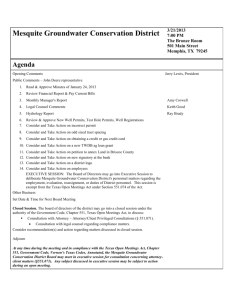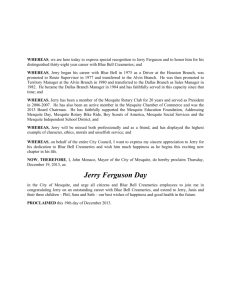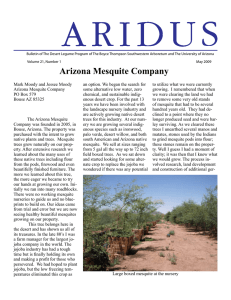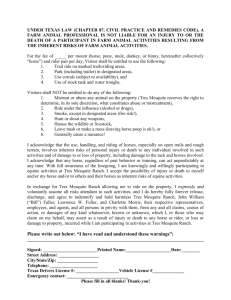Document 10685509
advertisement
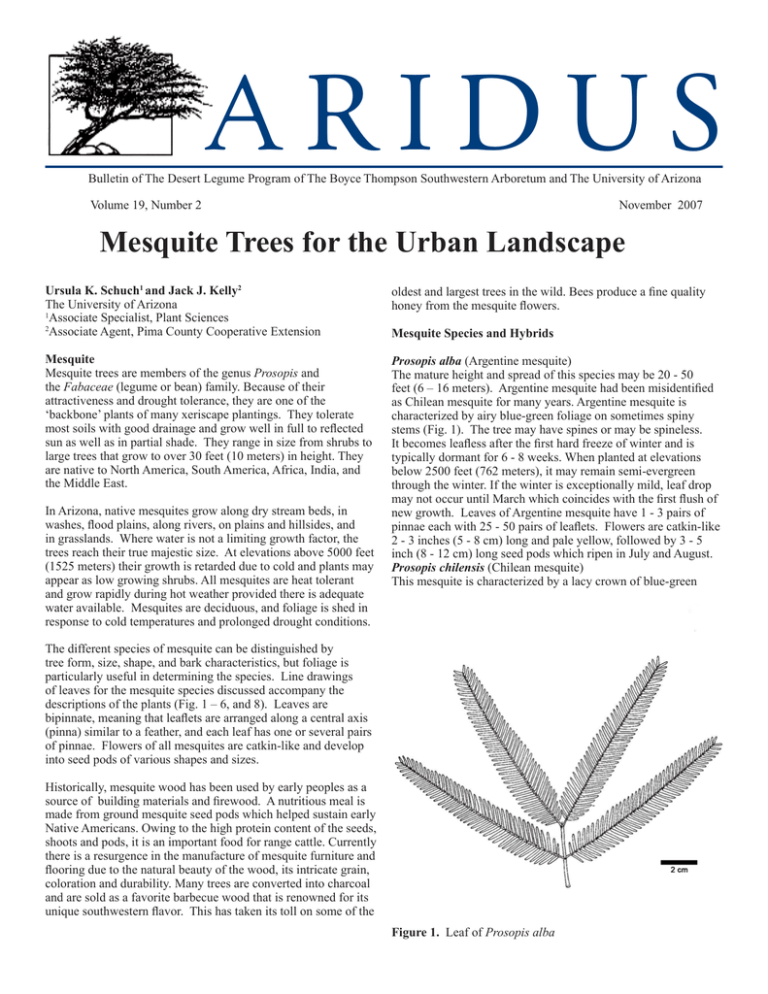
A R I D U S Bulletin of The Desert Legume Program of The Boyce Thompson Southwestern Arboretum and The University of Arizona Volume 19, Number 2 November 2007 Mesquite Trees for the Urban Landscape Ursula K. Schuch1 and Jack J. Kelly2 The University of Arizona 1 Associate Specialist, Plant Sciences 2 Associate Agent, Pima County Cooperative Extension oldest and largest trees in the wild. Bees produce a fine quality honey from the mesquite flowers. Mesquite Mesquite trees are members of the genus Prosopis and the Fabaceae (legume or bean) family. Because of their attractiveness and drought tolerance, they are one of the ‘backbone’ plants of many xeriscape plantings. They tolerate most soils with good drainage and grow well in full to reflected sun as well as in partial shade. They range in size from shrubs to large trees that grow to over 30 feet (10 meters) in height. They are native to North America, South America, Africa, India, and the Middle East. Prosopis alba (Argentine mesquite) The mature height and spread of this species may be 20 - 50 feet (6 – 16 meters). Argentine mesquite had been misidentified as Chilean mesquite for many years. Argentine mesquite is characterized by airy blue-green foliage on sometimes spiny stems (Fig. 1). The tree may have spines or may be spineless. It becomes leafless after the first hard freeze of winter and is typically dormant for 6 - 8 weeks. When planted at elevations below 2500 feet (762 meters), it may remain semi-evergreen through the winter. If the winter is exceptionally mild, leaf drop may not occur until March which coincides with the first flush of new growth. Leaves of Argentine mesquite have 1 - 3 pairs of pinnae each with 25 - 50 pairs of leaflets. Flowers are catkin-like 2 - 3 inches (5 - 8 cm) long and pale yellow, followed by 3 - 5 inch (8 - 12 cm) long seed pods which ripen in July and August. Prosopis chilensis (Chilean mesquite) This mesquite is characterized by a lacy crown of blue-green In Arizona, native mesquites grow along dry stream beds, in washes, flood plains, along rivers, on plains and hillsides, and in grasslands. Where water is not a limiting growth factor, the trees reach their true majestic size. At elevations above 5000 feet (1525 meters) their growth is retarded due to cold and plants may appear as low growing shrubs. All mesquites are heat tolerant and grow rapidly during hot weather provided there is adequate water available. Mesquites are deciduous, and foliage is shed in response to cold temperatures and prolonged drought conditions. Mesquite Species and Hybrids The different species of mesquite can be distinguished by tree form, size, shape, and bark characteristics, but foliage is particularly useful in determining the species. Line drawings of leaves for the mesquite species discussed accompany the descriptions of the plants (Fig. 1 – 6, and 8). Leaves are bipinnate, meaning that leaflets are arranged along a central axis (pinna) similar to a feather, and each leaf has one or several pairs of pinnae. Flowers of all mesquites are catkin-like and develop into seed pods of various shapes and sizes. Historically, mesquite wood has been used by early peoples as a source of building materials and firewood. A nutritious meal is made from ground mesquite seed pods which helped sustain early Native Americans. Owing to the high protein content of the seeds, shoots and pods, it is an important food for range cattle. Currently there is a resurgence in the manufacture of mesquite furniture and flooring due to the natural beauty of the wood, its intricate grain, coloration and durability. Many trees are converted into charcoal and are sold as a favorite barbecue wood that is renowned for its unique southwestern flavor. This has taken its toll on some of the Figure 1. Leaf of Prosopis alba 2 foliage on spiny stems (Fig. 2). Spines may be up to 2 inches (5 cm) in length which may limit its use in residential or high traffic areas. The trunk is typically dark brown and fissured. In the low and mid-desert, below 2,500 feet (762 meters), the tree will lose most of its foliage except in years of mild winter temperatures when foliage may remain on the tree until March. Old leaves do not fall from the tree until new growth is well underway. During cold winters the tree will be dormant and leafless for 6 - 8 weeks during winter. New foliage will appear in late March or early April and is fern-like and a beautiful light green. Leaves are characterized by 1 - 3 pairs of pinnae each with 10 - 29 pairs of widely spaced leaflets. Flowers are 1 - 3 inches (2.5 - 7.6 cm) in length and light yellow. Flowers are followed by 2 - 5 inch (5 - 13 cm) bean pods that ripen in July. Figure 2. Leaf of Prosopis chilensis Prosopis glandulosa var. glandulosa (Texas honey mesquite) This attractive ornamental tree grows to a mature height of 15 - 30 feet (5 - 10 meters) and is characterized by its weeping habit and shiny foliage which resembles Schinus molle (California pepper tree). It has small reddish spines and creamy white flowers. Leaves have 1-2 pairs of pinnae with 6 - 17 pairs of secondary leaflets per pinna (Fig. 3). The trunk is tan and smooth when young but becomes rougher and darker as the tree matures. Texas honey mesquite is native to the southwestern U.S. including Texas, Oklahoma, Kansas and into northern Mexico. Aridus 19:2 2007 Figure 3. Leaf of Prosopis glandulosa var. glandulosa Figure 4. Leaf of Prosopis glandulosa var. torreyana It resembles P. alba in many respects and has very similar form and foliage (Fig. 5). The leaflets of P. nigra are closely packed in dark green compound leaves. Leaves have 1 - 3 pairs of pinnae with 20 - 30 pairs of leaflets per pinna. Trunk color is dark brown to black. Unlike many members of the Prosopis genus, black mesquite is evergreen under most conditions. The plant Due to its ornamental popularity, several selections have been form is quite variable and may be heavily spined. With deep soil made for foliage, form and thornlessness. These cultivars are and adequate moisture the tree may grow to 30 feet (10 meters) vegetatively propagated to insure the integrity of the clone. Texas in height and width. It will tolerate being grown in irrigated honey mesquites require well drained soil and tolerate sun or turf areas and full-sun exposure. The wood is prized because of partial sun. Once established, plants irrigated monthly develop its beautiful brown streaking and is used to make furniture and into larger trees with a dense canopy. barrels. Flowers are typical catkin-like up to 2.5 inches (6 cm) long and yellow, and are followed by seed pods that are 4 - 6 P. glandulosa var. torreyana is similar in character to Texas inches (10 - 15 cm) long and are often streaked with pink. P. honey mesquite, but has smaller leaves with one pair of pinnae nigra is currently underused as it is not commonly available in and 8 - 24 pairs of leaflets per pinna (Fig. 4). It is native to west the trade, although it is an excellent tree for the low and mid- Texas, California, New Mexico and parts of Arizona and Mexico. elevation desert. This variety can sometimes be found in nurseries. Prosopis pubescens (Screwbean mesquite, Tornillo) Prosopis nigra (Black mesquite, Algarrobo negro) Screwbean mesquite grows to about 25 feet (7.6 meters) with P. nigra is native to Argentina, Paraguay and parts of Uruguay. 3 Aridus 19:2 2007 Prosopis velutina (Velvet mesquite) Figure 5. Leaf of Prosopis nigra an equal spread. P. pubescens is native to the Sonoran and Chihuahuan deserts in parts of southern Arizona, Texas, and New Mexico. The tree is characterized by unique seed pods that appear as a tightly wound spring or a screw, hence the common name (Fig. 6). ‘Tornillo’ means screw in Spanish. The tree is typically multi-stemmed and the bark on older branches is shaggy, flaky and easily peels from the tree. Typical form of the tree is vaselike, very open and spreading. The leaves are smaller than the other mesquites described above and are characterized by one pair of pinnae with 5 - 9 pairs of leaflets per pinna. Each leaflet is approximately 3/8 to 1 inch (1 - 2.5 cm) in length (Fig. 6). The small ¾ inch (2 cm) spines are whitish, slender and appear as pairs along the branches. Catkin-like flowers are bright yellow. This tree grows very slowly without irrigation. Figure 6. Leaf and seed pod of Prosopis pubescens Figure 7. Prosopis velutina in winter (above) and spring (below) Mature size of velvet mesquite is 30 - 50 feet (9 - 15 meters) height and spread (Fig. 7) when grown with adequate water and in deep soils. Growth rate is slow to moderate but moderate to rapid under irrigation. Velvet mesquite is native from central and southern Arizona into Mexico. It grows as a shrub on dry rocky upland sites but will grow much larger under ideal conditions. This tree may be found as a single-stemmed tree in bosques (thickets) or as a multi-stemmed tree in open areas. The bark is fissured, dark brown and rough. The wood is prized for furniture because of its unique coloration and intricate grain. Trees may grow up to 4 feet (1.2 meters) in trunk diameter and live for several hundred years. Velvet mesquite foliage is covered with dense short gray hairs that cover most parts of a younger plant (Fig. 8). Filtered shade from velvet mesquites is light and often serves as a nurse tree for other slower growing plants. Leaves have one or two pairs of pinnae (Fig. 8) with 12 - 30 pairs of leaflets each. In late fall or early winter after the first hard freeze, the gray-green, fine textured leaflets turn light green or tan and fall from the tree revealing a beautifully sculptured trunk and scaffold branches. In spring 2-3 inch (5 - 7.5 cm) long cream-colored flowers adorn the tree followed by tan seed pods which ripen in mid to late summer. Young velvet mesquites have small spines which become less problematic as the tree matures. Velvet mesquite trees are drought tolerant yet will flourish with moderate irrigation. They may become unstable due to rapid crown growth and a limited root system in lawn conditions. Hybrid mesquites 4 Aridus 19:2 2007 alkaline and poor soils. Mesquite trees are not well suited as street trees due to their multi-trunk character. The cold tolerance of many species has been established but this tolerance is quite variable owing to the condition of the plant at the onset of winter. Heavily fertilized and irrigated trees will not tolerate the cold as well as those that have been conditioned with less water and no fertilizer late in the summer. Honey mesquite (Prosopis glandulosa) and screwbean mesquite (P. pubescens) can survive temperatures to 0 ºF (-18 ºC); velvet mesquite (P. velutina) is reliably cold hardy to at least 10 ºF (-12 ºC); Chilean mesquite (P. chilensis) and black mesquite (P. nigra) are hardy to at least 15 ºF (-9 ºC); Argentine mesquite (P. alba) and many South American hybrids suffer damage and dieback when temperatures fall below 15-20 ºF (-9 to -7 ºC). Where there is abundant water present, mesquite specimens will be largest when grown in deep, uniform, sandy soils in and along streambeds, and alluvial plains. With proper irrigation, these trees will grow satisfactorily on any well drained soil. Figure 8. Leaf and seed pod of Prosopis velutina Mesquites cross pollinate quite readily and as a result there are a group of plants that are simply called ‘hybrid mesquites’. They are often the result of natural hybridization of Prosopis alba (Argentine mesquite), P. chilensis (Chilean mesquite) and native P. velutina. Because of this hybridization, it is almost impossible to obtain pure species seed. Most hybrids are typically fast-growing, attractive, spiny or spineless, may have delicate blue green or green foliage or may have small leaves and have intermediate characteristics of the above described species. Many of the hybrid mesquite leaves persist until the new growth begins in spring, giving the tree an almost evergreen appearance. These hybrids are often sold in the trade as ‘Chilean’ mesquite or ‘South American Hybrids’. Hybrid mesquites are noted for their rapid growth and can attain a mature height of 30 - 40 feet (9 - 13 meters) with a spread of up to 30 feet (9 meters). They make an excellent large shade tree but given their size, are often unsuited for the smaller yards found in newer subdivisions. Many homeowners seek out the spineless hybrids and as a result, selections of trees having no spines and superior structural and aesthetic characteristics have been made. To preserve these characteristics, trees either are grown from cuttings, are air layered, or are grafted. Spines, which are modified leaves, often disappear as the tree matures. In situations where spines (which can be up to 2 inches (5 cm) long) are objectionable, they may be pruned off young trees and will not re-grow from this location again. Culture All mesquites are very tolerant of hot south and west-facing walls, are valuable trees in parks or large public areas, and are an asset in low water-use landscapes. They may be planted in groups or as solitary specimens and add a lush appearance to the landscape. Mesquites are well suited to heat, low humidity, Problems There are few problems of mesquites. Mistletoe (Phoradendron californicum) can be a nuisance or develop into a more serious problem for heavily infested trees. True mistletoe contains chlorophyll and carries on photosynthesis, but being a parasite it also lives off the nutrients of the host plant (Fig. 9). It can develop into plants that are several feet (meters) in diameter. Mistletoes may be a problem if left unmanaged and while it generally does not kill a tree, it can cause significant decline over time. If not pruned out, the weight of the mistletoe can become great enough that the branch may break off. Manual removal of mistletoe is the only practical control however, removal does not kill the mistletoe as it continues to grow inside the wood. Since mistletoe is a part of the desert ecology, it is an aesthetic decision whether to remove it or not on lightly infested trees. Mistletoe berries are a primary food source of desert birds and only in few situations the mistletoe becomes large enough to warrant removal. Figure 9. True mistletoe aerial shoots with berries Slime flux is caused by the infection of sapwood by several bacteria and is a problem with mature mesquites. The disease causing microorganisms are found in the soil and probably gain entry through above or below the soil line wounds or pruning cuts. After several years, affected areas will exhibit a watersoaked appearance (wet wood). Gas is produced by the bacteria (and possibly yeasts) which force out a foul smelling liquid from cracks and wounds. The liquid is dark brown to black in color Aridus 19:2 2007 5 (Fig. 10). Infected trees live many years and slime flux is more of a nuisance that requires periodically a strong, hard stream of water to prevent staining of patios and cars. Seriously infected branches may need removal if they present a safety hazard. The old remedy of placing drainage tubes into the infected areas is not recommended and may in fact, present more entry sites for the disease. Figure 12. Nymph of giant mesquite bug (Thasus californicus) Figure 10. Slime flux on Prosopis sp. Ganoderma root rot (Ganoderma) is caused by a soil-borne fungus and enters mesquite roots primarily through wound sites. Root rot causes slow decline and eventually death of mature trees. There is no recommended treatment for infected trees. Fruiting bodies at the base of the tree are most common during the summer rainy season. They start as white structures at the base of the tree and develop into light brown, shelf like fruiting bodies (Fig. 11). Figure 11. A shelf-shaped mushroom of a woody decay fungus (Ganoderma sp). During the summer months, the giant mesquite bug (Thasus gigas) makes its appearance. Although it looks threatening because of its size and dramatic markings, it is just another insect that is part of the desert ecology. No control is recommended for these insects as their damage is minimal. The adults are up to two inches (5 cm) long and have brown and yellow markings on their forewings and red and black banding on their legs. What makes these insects interesting is that the immature insects (nymphs) are banded an attractive red and white and may appear in large numbers in early April (Fig. 12). Although menacing looking, they are not considered a damaging pest of mesquites. Another minor pest of mesquite is the mesquite twig girdler (Oncideres rhodosticta) which may appear in early to midsummer. The adult cuts a channel around the stem and deposits her eggs in now girdled portions. The resulting damage is ‘flagging’ or browning of the girdled stems. Since the damage is cosmetic, no control is recommended. Miscellaneous wood borers may appear from time to time in older, neglected or stressed trees. There beetles are typically drawn to trees that are under severe stress and are considered secondary pests. Irrigation related issues can cause problems for mesquite trees or surrounding vegetation. Infrequent shallow watering for turf will encourage surface rooting rather than the deep root development that proper irrigation of trees will provide. Mesquite trees can become unstable with excess irrigation, such as in lawns, due to rapid crown growth and limited root system development. Another irrigation related problem is improper placement of drip emitters. By placing emitters close to the trunk, roots primarily develop in these areas. Placing the emitters further out (at the dripline of the tree and beyond) will help establish a root system which gives stability to the tree and reduces the occurrence of tree toppling and possible tree loss. Root binding can be a problem of mesquite trees when purchased in containers. Most mesquite species grow very fast under cultivation. If not transplanted to larger containers in a timely manner, roots start circling around the outside of the root ball and in some cases close around the trunk. If not corrected by pruning circling roots at transplanting, this condition can lead to problems of tree failure. This manuscript was originally published by Arizona Cooperative Extension. References Benson, L. and R.A. Darrow. Trees and Shrubs of the Southwestern Deserts. UA Press. Jones, W. and C. Sacamano. 2000. Landscape Plants for Dry Regions. Fisher Books, Tucson, AZ. Burkart, A. 1976. A Monograph of the Genus Prosopis (Leguminosae subfam. Mimosoideae). Journal of the Arnold Arboretum 57(3,4): 219-249, 450, 525. Acknowledgements Line drawings are courtesy of Matthew Johnson except Figure 6 which is by Lucretia Hamilton (Benson and Darrow); Figure 12 is courtesy of Carl Olson; Figures 9 and 11 are courtesy of Dr. Mary Olsen. Aridus 19:2 2007 6 WelcometoDELEP! DELEP welcomes its newest member of the DELEP team, Kirsten Lake. Kirsten began her position with DELEP in June of this year. She is working full time on the DELEP project Legumes of Arizona, an Illustrated Flora and Reference. This treatment will include native, naturalized, and commercially grown taxa of Fabaceae in Arizona. It is intended to serve as a major reference on these plants for a broad audience including naturalists, resource managers, educators, horticulturists, ranchers, and gardeners. The completed book will consist of identification keys to and written descriptions of each taxon, supplemented with photographs and/or illustrations and distribution maps. Information on known or potential uses will be provided for each plant. Conservation status of rare taxa will be highlighted. It is the steering committee’s hope that upon completion of the flora, the project will continue to develop and provide a resource to the community. One project that we would like to implement is a website that would make project data, such as distribution maps and photos, available to the public. Kirsten graduated from the University of Arizona in 1994 with a Bachelor of Science degree in Ecology and Evolutionary Biology. After graduation, Kirsten joined the Peace Corps as an Education Specialist in Nicaragua. Her work included curriculum development and the development of a science library. After the Peace Corps, Kirsten returned to Tucson and joined an engineering firm as a staff biologist. She was responsible for environmental compliance on projects in Arizona, California and New Mexico. Currently, Kirsten is working on development of a contributor’s guide. The guide will describe project objectives and provide instructions for treatments by contributors. She is also collecting illustrations and photographs for use in the flora. Committee members have been working on development of a final list of taxa to be described in the flora and a list of taxa in need of collection. Most recently, committee members have discussed guidelines for distribution maps and begun identification of resources needed for their completion. Initial major funding for the Legumes of Arizona project is provided by a grant from the Wallace Research Foundation. The Legume Family is one of the most economically and agriculturally important plant families in the world. Despite this, there is no comprehensive reference to these plants for the United States or the state of Arizona. Legumes of Arizona will fill this void and be a valuable research tool for plant scientists in many fields of research. KL Kirsten at work in the herbarium. (MBJ) Delep Personnel Volunteer Coordinators Advisory Board MichaelChamberland ElizabethDavison DavidEllis,Ph.D. StefanieGreene,Ph.D. KenMorrow RaymondTurner,Ph.D. MarkBierner,Ph.D. Director MatthewB.Johnson BotanicalSpecialist KenCoppola Horticulturist Margaret Norem, Ph.D. EditorAridus KirstenLake FloristicsCoordinator BruceKlewer AdministrativeAssistant GlennBranham PamelaHonaker JamieWahl YumaFields DanSims Greenhouses LeslieGunatilaka,Ph.D. RyanHuxtable,Ph.D. MichelleMcMahon,Ph.D PamelaSlate Aridus 19:2 2007 7 Staff and Volunteers in Action Desert Legumes: Enduring Tough Times TheseverefreezesinTucsonduring the2006/2007wintercausedamodest amount of damage to plants in our fields, andafewpreviouslyunremarkable specimenswerekilled.Iamgrowing replacementspecimensfortheBoyce ThompsonArboretumwhereseveral plantswerekilledbythosefreezes. Extremeweatherconditionscreatea scenario for important data collection, as reported in ARIDUS Volume 19, number 1.Theserareoccurrenceshavebeena valuabletoolforbetterplantdescription andnewknowledgeaboutdesertlegume horticulture, during nearly twenty years of DELEP’sexistence. GroundskeeperWayneMacGowanandIhavedevotedaconsiderable amountofthelatesummermonthstoremovingthefrost-damagedplantmaterial. A rainy summer, with warm temperatures resultedinafairamountofnewgrowth formanyplants.Butthatcoldwintermay be the cause of reduced flowering on many ofourspecimens.Seedcollectionsfrom manyspecimensherehavebeennoticeablysmallerthisyear. TheDesertLegumeProgram Advisory Board met on Friday, October 5th.ThankstoDr.LeslieGunatilakafor hostingourforumattheSouthwestCenter forNaturalProductsResearchandCommercialization, of which he is the Director. The meeting was well attended, and it was the final meeting for four of the volunteer advisors. Our gratitude to Ms. Rita Jo Anthony, Ms. Kathy Rice, Dr. Suzanne Nelson, and Dr. Ursula Schuch for their yearsofassistanceonouradvisoryboard. Threenewboardmemberswilljoinusat ourspring2008meeting.Theyare:Ms. Pamela Slate, Botanical Garden Coordinator at Wallace Desert Gardens in Carefree, Arizona; Mr Michael Chamberland, DirectorofHorticultureatTucsonBotanical Garden; and Dr. Raymond Turner, an ecologistwithmanyyearsofassociation withtheDesertResearchLaboratoryat the University of Arizona. Finally, thanks toMr.AdamRyanforhisworkasour groundskeeperfrom2003untilthisyear. Upcomingvolunteersessionswill beonNovember14thandDecember12th. Spring2008volunteersessionsarescheduled on Wednesdays: January 9th, February 13th, March 12th, April 10th, and May 14th. Pleasecallorsendanemailtome(kcoppola@ag.arizona.edu)tolearnmore.KC Opportunities for Participation DELEP’s bulletin Aridus, is published three times annually to stimulate interest in desert legumes, to inform our readers of DELEP’s activities, and to encourage support for DELEP’s programs. Manu­ scripts related to legumes are welcome and should be mailed to the editor for review. Subscriptions are complimen­ tary and are available by contacting the DELEP office. Aridus is published by The University of Arizona on behalf of The Desert Legume Program. Financial support for DELEP comes from contracts, grants and contributions from private industries, government agencies and individuals. To Contribute: Send a check, payable to U of A Foundation/ DELEP, or call the DELEP Office concerning a pledge, a restricted gift, or estate planning. The Desert Legume Program 2120 E. Allen Road Tucson, Arizona 85719 Dedicated volunteer work is an integral component of DELEP. Our volunteers come from many backgrounds and work on a variety of projects including wild seed collecting, seed processing, organization of special events, and of­ fice work. To Volunteer: Or just to explore the possibilities, telephone our office (520) 318-7047) or drop us a note or email: kcoppola@ag.arizona.edu. Aridus 19:2 2007 8 Abrus precatorius flowers (KC) The University of Arizona Desert Legume Program 2120 East Allen Road Tucson, Arizona, 85719 U.S.A. Return Service Requested NON-PROFIT ORGANIZATION U.S. POSTAGE PAID PERMIT NO. 190 TUCSON, ARIZONA

